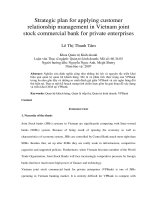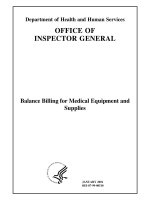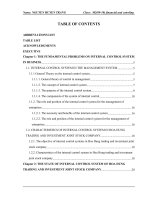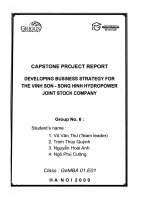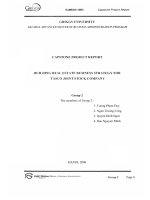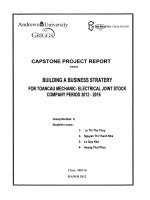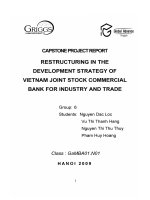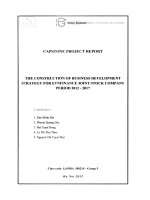Improving air freight service for medical equipment import at airseaglobal vietnam joint stock company
Bạn đang xem bản rút gọn của tài liệu. Xem và tải ngay bản đầy đủ của tài liệu tại đây (748.93 KB, 99 trang )
ACADEMY OF POLICY AND DEVELOPMENT
INTERNATIONAL SCHOOL OF ECONOMICS AND FINANCE
GRADUATION THESIS
Topic: “Improving air freight service for medical equipment
import at Airseaglobal Vietnam Joint Stock Company”
Instructors:
Student:
MA. Doan Anh Tuan
Student Code :
5083106556
Class:
CLC 8.2
Major:
International Business Economics
School year :
2017 - 2021
Dien Ngoc Anh
Ha Noi, June 2021
i
ACKNOWLEDGMENT
In fact, behind every success of a research, it is impossible not to mention the
enthusiastic help of teachers. Therefore, I would like to express my deep gratitude to the
teachers at the International School of Economics and Finance - Academy of Policy and
Development, especially my instructor – MA.Doan Anh Tuan, who has been dedicated to
teaching and caring, guide, and create conditions for me to be able to best complete the
graduation thesis.
To complete the research paper on the topic "Improving air freight service for
medical equipment import at Airseaglobal Vietnam Joint Stock Company ", I would
like to express my deep gratitude to all managers and staffs in the Joint Stock Company
Airseaglobal Vietnam has enthusiastically helped and trusted to provide me with enough
information to be able to complete my thesis.
Although there are many efforts to implement the thesis in the most complete way,
but due to the limitations of knowledge and experience, it is inevitable that there are
shortcomings that I have not seen myself. I look forward to receiving suggestions from
teachers and interested people to help the topic be more complete.
To complete this thesis, I have researched the actual competitiveness of import and
export freight forwarding services by air at Airseaglobal Vietnam Joint Stock Company based
on the knowledge I have learned at the Academy of Policy and Development. Once again, I
would like to sincerely thank the teachers at the Academy of Policy and Development and
managers and staffs in Airseaglobal Vietnam Joint Stock Company for helping me in the past
time. I would like to wish your company always develop and be sustainable, wish all
members in the company and teachers always healthy and successful.
Best regards!
Student
Dien Ngoc Anh
i
TABLE OF CONTENTS
Contents
ACKNOWLEDGMENT...................................................................................................................i
LIST OF ARRIVAL CHARACTERS.............................................................................................iii
LIST OF FIGURES.........................................................................................................................iv
LIST OF TABLES............................................................................................................................v
INTRODUCTION............................................................................................................................1
Chapter 1: Theoretical basis for import and export goods delivery by air.......................................4
1.1.
Overview of import and export freight forwarding activities............................................4
1.2.
Professional process of forwarding and receiving goods imported by air.......................12
1.3. The criteria for evaluating the results of business activities of import and export freight
forwarding services.....................................................................................................................20
1.4.
Factors affecting business activities of freight forwarding services by air......................26
Chapter 2: Analysis of the reality of delivery and receipt of imported medical equipment by air at
Airseaglobal Joint Stock Company................................................................................................32
2.1.
Current status of medical equipment delivery at Airseaglobal Joint Stock Company.....32
2.2.
Medical Equipment overview..........................................................................................41
2.3. Reality of forwarding activities at Airseaglobal Joint Stock Company.............................45
2.4. Analyzing and evaluating the process of receiving imported medical equipment from
Airseaglobal Joint Stock Company............................................................................................ 59
Chapter 3: Solutions to improve the quality of air freight service for medical equipment import at
Airseaglobal Vietnam Joint Stock Company................................................................................. 71
3.1. Orientation to develop the delivery service of medical equipment imported by air at
Airseaglobal Vietnam Joint Stock Company in the coming years............................................. 71
3.2. Solutions to improve the process of delivery and receipt of medical equipment by air at
Airseaglobal Vietnam Joint Stock Company..............................................................................72
3.3. Several recommendations for state agencies..................................................................... 76
CONCLUSION.............................................................................................................................. 82
REFERENCES...............................................................................................................................83
ii
LIST OF ARRIVAL CHARACTERS
iii
LIST OF FIGURES
Figure 1. 1: Import and export freight forwarding process............................................... 13
Figure 1. 2: Steps to do customs procedures..................................................................... 15
Figure 1. 3: Method of net sales growth rate.................................................................... 22
Figure 1. 4: Method of Profit growth rate......................................................................... 22
Figure 1. 5: Method of ROA............................................................................................. 25
Figure 1. 6: Method of ROE............................................................................................. 25
Figure 2. 1: Organization chart of the company................................................................ 34
Figure 2. 2: Chart comparing revenue and profit in recent years of Airseaglobal Joint
Stock Company................................................................................................................ 37
Figure 2. 3: Chart of the proportion of business sectors contributing to Airseaglobal's
revenue in 2020................................................................................................................ 38
Figure 2. 4: Bussiness Ratios............................................................................................ 41
Figure 2. 5: The percentage of capital used by the company for operations.....................56
Figure 2. 6: The process of delivery and receipt of medical equipment by air at
Airseaglobal Vietnam Joint Stock Company.................................................................... 62
Figure 2. 7: The process of electronic clearance of medical equipment............................66
iv
LIST OF TABLES
Table 1. 1: The legal system governing air freight forwarding and forwarding services in
Vietnam…………………………………………………………………………………31
Table 2.
1: Revenue and profit in recent years of Air
Table 2.
2: Growth rate of the company in the perio
Table 2.
3: Total asset and equity .............................
Table 2.
4: The proportion of quality goods delivere
Company .............................................................................................................................
Table 2. 5: Freight forwarding volume of Airseaglobal Joint Stock Company from 2018 to
2020 ....................................................................................................................................
Table 2. 6: Equipment in stock of Airseaglobal JSC .........................................................
Table 2. 7: Number of employees of the company by age .................................................
Table 2.
8: Total capital of the company ..............
Table 2.
9: Purpose of using capital of the compan
Table 2.
10: Total volume of imported and export
Table 2.
11: Total number of shipments delivered b
in recent years .....................................................................................................................
Table 2.
12: Number of customers of the company i
Table 2.
13: The company main import routes ........
Table 2.
14: Results of delivery of medical equipme
past 3 years .........................................................................................................................
v
INTRODUCTION
1. The urgency of the subject
Currently, the process of globalization and integration is growing, making
economic activities in general and international economic activities in particular go up at
a stronger speed. Grasping that situation, the international freight forwarding market is
also very exciting, businesses compete with each other to gain prestige and great position,
towards sustainable development in the future. Import and export freight forwarding
services make trade activities easier to circulate, helping production, trading and importexport enterprises save costs thanks to production specialization. Besides sea freight
forwarding, which is still bringing great advantages to businesses, air freight forwarding
has also become exciting and competitive in recent years.
In Vietnam, there are more than 2,000 forwarding companies and will increase
significantly, leading to fierce competition in the market. International freight forwarding
services are associated with the economic development of each country. The systematic
study of issues related to international freight transport is an urgent requirement for
officials working in freight forwarding, importing and exporting.
Airseaglobal Vietnam Joint Stock Company has been operating in the market for
about 9 years, in addition to the delivery and receipt of medical equipment by sea, the
company's air freight forwarding activities still account for the largest share. big.
However, this activity is still not in the top position because a number of weaknesses in
the process of making import documents, receipt and delivery procedures have not been
completely overcome. Therefore, it is imperative to find effective solutions to overcome
the shortcomings so that the air delivery and delivery of medical equipment by air
becomes more efficient and achieves a higher frequency. . Because of the above reasons, I
have chosen the topic: " Improving air freight service for medical equipment import
at Airseaglobal Vietnam Joint Stock Company ".
1
2. Purposes and tasks of the research
The purpose of the study is through analyzing the current situation to propose
orientations and solutions to improve the delivery and receipt of medical equipment by air
at Airseaglobal Vietnam Joint Stock Company.
To achieve the above goal, the study carried out the following research tasks:
Systematize the theoretical basis of freight forwarding by air, the steps in the
delivery and receipt process, the factors affecting the forwarding process of Logistics
companies;
Analysis of the reality of medical equipment delivery by air at Airseaglobal
Vietnam Joint Stock Company;
Analysis of influencing factors; assess the positive and negative aspects of the
company's air delivery and delivery of medical equipment;
Solution offered to complete the process of delivery and receipt of medical
equipment by air at Airseaglobal Vietnam Joint Stock Company.
3. Objects and scope of research
a. Research objects:
The object of the study is the delivery and receipt of medical equipment by air at
b. Research scope:
Information and data are collected for 3 years from 2018 to 2020 and specific
solutions oriented from 2021 to 2025.
4. Research Methods
To complete the thesis, during the internship to survey reality, collect relevant
information and data at Airseaglobal Vietnam Joint Stock Company, the writer used
research methods such as: collection method. data collection, statistical methods,
comparative methods, analytical methods, conceptualization methods, synthesis methods.
The methods that have been specifically used in the chapters are as follows:
2
In chapter 1, the writer uses the method of conceptualization, analytical method,
and systematization method to systematize and analyze some basic theories about the air
freight forwarding process; the process of freight forwarding by air and the necessity of
freight forwarding activities in import and export activities and analysis of factors
affecting freight forwarding activities.
In chapter 2, the writer uses analytical methods, statistical methods, and
comparative methods to analyze the actual situation in the process of delivery and receipt
of medical equipment by air at a joint stock company. Airseaglobal Vietnam.
In chapter 3, the writer uses analytical, synthesis, and systematization methods to
provide orientations, predict opportunities and challenges, and propose solutions to
improve the delivery process medical equipment goods by air at Airseaglobal Vietnam
Joint Stock Company in the near future.
5. Structure of the research
Apart from the introduction, table of contents, list of references, the thesis is divided
into three specific chapters as follows:
Chapter 1: Theoretical basis for import and export goods delivery by air.
Chapter 2: Analysis of the reality of delivery and receipt of imported medical
equipment at Airseaglobal Joint Stock Company.
Chapter 3: Solutions to improve the quality of air freight service for medical
equipment import at Airseaglobal Vietnam Joint Stock Company.
3
Chapter 1: Theoretical basis for import and export goods delivery by
air
1.1.
Overview of import and export freight forwarding activities.
1.1.1. Some definitions and classification of freight forwarding services
1.1.1.1.
Definitions
1
Import and Export : Export of goods is the activity of selling goods to foreign
countries, it is not an act of individual sales, but an organized sales system of economic
organizations for the purpose of generating profits, promoting production, commodity
production to develop, to transform the economic structure, to stabilize and gradually
raise the people's living standards. Exporting is a business activity that can increase the
income of an enterprise in particular and of the entire economy in general.Commodity
importation is an international trading activity, which is the process of exchanging goods
between countries based on the principle of parity exchange for currency as a broker. It is
not a single act of trade but a system of trade relations in an economy. Thus, import and
export of goods is the purchase and sale of goods with foreign countries to develop
production and business life. But trading here has its own complicated features such as
dealing with people of different nationalities, a large market that is difficult to control,
buying and selling through intermediaries accounts for a large proportion, payment in
foreign currencies. Goods transported across border gates and border gates of different
countries must comply with international as well as local customs…
2
Delivery : Freight forwarding are activities in the circulation and distribution stage,
an important stage connecting production and consumption, the two main sides of the social
reproduction cycle. Freight forwarders perform the function of bringing products from the
place of production to the place of consumption, completing the second side of the
distribution and physical circulation, when the first side is the commercial procedure has
formed. Forwarding is associated with and parallel with the transportation process. Through
forwarding, transportation operations are carried out. Collection of goods, transportation,
loading and unloading, storage, transmission, packaging, procedures, documents ... With such
broad content, there are many definitions of forwarding and forwarding: According
1 />2 />
4
to the rules of the form of the Federation of International Freight Forwarders
3
Associations (FIATA) , a forwarding service is defined as any type of service relating to
the transportation, consolidation, storage, handling, packaging or distribution of goods as
well as consulting services related to the above services including customs, financial,
insurance, payment, income, documents related to goods.
4
Commercial Law 2005 : Forwarding is a commercial activity, whereby a person
providing freight forwarding services, organizing transportation, storage and warehousing
is doing other related services to deliver goods to the recipient according to authorization
of the shipper, carrier or other forwarder. Export of goods means that goods are taken out
of the territory of Vietnam or brought into a special area located in the territory of
Vietnam which is considered a separate customs area according to the provisions of law.
Import of goods means that goods are brought into the territory of Vietnam from abroad
or from a special area located in the territory of Vietnam which is considered a separate
customs area according to the provisions of law. So basically, freight forwarding is a
collection of jobs related to the transportation process in order to move goods from the
place of shipment (Consolidator) to the place of receipt (Consignee).
1.1.1.2.
The necessity of forwarding activities in import and export of goods
Forwarding activities are activities that play an important role in determining the
completion of the import-export process. Therefore, freight forwarding in general and
delivery services in particular are of great significance. To clarify this, I put forwarding
on two perspectives, namely the role of forwarder and the responsibility of forwarder in
import and export of goods for analysis. Forwarding activities develop in the direction of
international economic development, forwarders play the role of carriers, consolidators,
agents and customs brokers.
The development of production requires the corresponding development of
circulation and trade. In which transportation and freight forwarding occupy a very
important position. In the economy of every country or the global economy, air transport
3 />4 />
5
is likened to a blood vessel for a living organism, creating the driving force for strong
economic development. Air transport compared to other modes is quite young, about a
century old. Especially after the 2nd world war, air transport has made great strides due to
the achievements of science and technology and began to be used for civilian purposes. In
recent years, air transport has developed very rapidly, especially in the Asia Pacific
region. Although newly born, but air transport has developed very quickly due to the great
progress of science and technology and the high-speed needs of human civilization.
5
Today, air transport has Boeing's 70-ton aircraft (B747-300) with a speed of 11,000 km/h
(Boost. Glide. Vihichle - BGV). This plays an important role in establishing and
expanding many different economic zones, creating common development for the whole
world. Although carrying only 1% of the total volume of goods, it accounts for 20% of
the value of goods in international trade. With its own characteristics, air transport can be
developed in economically developed areas with good infrastructure. In the world today,
airport clusters are concentrated mainly in North America, Europe, Northeast Asia, and
recently there has been a remarkable development of Asia - Pacific countries. Besides,
almost all countries have their own airport clusters and are growing and developing
constantly.
1.1.1.3. Types of forwarding services6
•
Air freight forwarding service:
Air freight is one of the highly competitive forms of transportation in the field of
logistics today, using aircraft to transport goods. Goods are carefully packed and loaded onto
specialized cargo planes or cargo cabins of passenger aircraft. Along with the development of
the economy, the open trade between countries, this form of transportation has become more
and more popular and dominant. Compared with sea transport, air freight will be less
common because this type of freight is limited in terms of the type of goods as well as the
volume and size of the goods. However, internationally, this is considered an
5 />6 />
6
attractive and potential market because of its very fast and safe delivery speed. This form
of transportation brings a lot of advantages, but there are still many disadvantages:
Pros: Airmail makes it easy to ship goods abroad. The problem of collision is also
rare because the accident rate is very low, ensuring the safety of goods better.
Cons: Although this form is very effective, it is only used to transport personal
goods, simple and light. With bulky goods, very few options are available because the
transportation costs are quite high. The volume of goods is also limited and customs
procedures when transporting goods are also quite complicated and time consuming.
•
Sea freight forwarding service:
Sea transport is a form of freight transport using means of transport and sea
infrastructure to serve the purpose of transportation. Commonly used means will be boats
and means of loading and unloading goods such as cranes... Infrastructure to serve sea
transport includes seaports and transshipment ports. Sea transport is suitable for areas
with adjacent waters and ports for ships to dock. Shipping can be done by sea freight
domestically or internationally. Because shipping vessels are often large in size and
tonnage, usually sea transport is widely applied to the import and export industry to carry
large quantities of goods.
Pros: Sea freight is used to transport long-term goods, especially international
shipments. Transport routes are more comfortable and open than road transport. Can
transport many goods with large volume and size. The cost of transporting goods is not
too high compared to road transport, so in cities with seaports, this mode of sea transport
is often used.
Cons: If transported by ship, it is not possible to deliver goods to the place, but
must dock at ports and transfer by car to the mainland. Because of sea operations, the
shipping time is slow and depends a lot on weather factors. Besides, the goods are easily
affected by each other if there is an incident on the ship during transportation.
•
Delivery service by road:
7
Road transport is the most common and popular form of transport in all modes of
transport. Jute is a method of transporting goods by means of transport on the road such
as cars, passenger cars, trucks, tank trucks, container trucks, trailers, semi-trailers towing
cars... small scale and domestic, usually between provinces and localities in the country.
Pros: Road transport mainly uses motorbikes and trucks, so it is very flexible in the
process of transporting goods, does not depend on time and does not have a specific time,
but only the parties Self-unified time as well as may change during transportation.
Choosing the own means of vehicle, quantity of goods or route as required. Therefore,
this method helps to save costs and labor, except in the case of long-distance
transportation, which may incur additional costs.
Cons: long-distance transportation often has to pay additional road surcharges: toll
stations, fuel fees, tolls... Road transport also contains many risks such as traffic
accidents, traffic jams, etc. Great influence on goods and delivery time. The volume of
goods transported is also much more limited than by waterways and railways.
1.1.2. Forwarders and freight forwarding organizations.
1.1.2.1.
Definition
7
According to FIATA, the forwarder is the person who takes care of the goods
transported under the trust contract and acts in the trustee's interest. The forwarder also
ensures to undertake all work related to the delivery contract such as preservation, transit
storage, customs clearance, inspection.
The forwarder can be the owner of the goods (when the goods owner himself takes
over the work of delivering and receiving his goods), the ship owner (when the ship owner
performs the forwarding service on behalf of the goods owner), the loading and unloading
company or warehouse, professional forwarder or any other person who has registered for
freight forwarding service business. Forwarders with qualifications such as: (i) Know how to
combine many modes of transport together; (ii) Know how to maximize the capacity and
7Phạm Mạnh Hiền (2012), “Nghiệp vụ giao nhận vận tải và bảo hiểm trong ngoại thương”, NXB Lao
động – xã hội
8
tonnage of transport tools thanks to the delivery service; (iii) Know the combination of
transport - forwarding - import and export and have good contact with organizations related
to the process of transporting goods such as customs, shipping agents, insurance, ports …;
(iv) Forwarders also create favorable conditions for import and export business to operate
effectively thanks to their forwarding services. Thus, the importer and exporter can use
the warehouse of the forwarder or the hired forwarder, thereby reducing warehousing
costs. Besides, it also reduces costs such as financial management, simple organizational
structure, and conditions to focus on import and export business.
1.1.2.2.
Rights and obligations of the forwarder:
Article 167 of the Commercial Law stipulates that the forwarder has the following
rights and obligations: The forwarder is entitled to remuneration and other reasonable
income; Fully perform your obligations under the contract; In the course of contract
performance, if there is a legitimate reason for the benefit of the customer, it can be done
differently from the instructions of the customer, but must immediately notify the
customer; After signing the contract, if it is found that it is impossible to carry out the
instructions of the customer, it must notify the customer for further instructions; Having
to perform its obligations within a reasonable time if the contract does not agree on the
time to perform obligations with the customer.
1.1.2.3. Responsibilities of the forwarder
Agents of the owner: Depending on the functions of the forwarder, the forwarder
must fulfill his obligations under the signed contract and be responsible for: Delivery not
according to instructions; Failure to buy insurance for goods despite having instructions;
Shortcomings while doing customs procedures; Carrying goods to the wrong place;
Deliver goods to people who are not recipients; Delivery without collecting money from
the consignee; Re-export does not follow necessary procedures or does not refund tax;
Damages to property and people of a third party that he causes. However, the forwarder is
not responsible for the fault of a third party such as a carrier or another forwarder....When
acting as an agent, the forwarder must comply with their "Standard Trading Conditions".
9
The carrier: As a carrier, the forwarder acts as an independent contractor,
responsible for providing the services requested by the customer on his behalf:
Firstly, the caririers shall be liable for the acts and omissions of the carrier, of the other
forwarder he hires to perform the contract of carriage as if his own acts and omissions.
Secondly, their rights, obligations and responsibilities are determined by the laws of
the modes of transport. The carrier collects from the customer the price of the service he
provides, not a commission.
The forwarders act as carriers not only in case they carry the goods themself by thei
own means of transport (perfoming carrier) but also where they, by issuing transport
documents, act as a carrier. Their own load or otherwise, undertakes to assume the
responsibility of the carrier (contracting carrier). When the forwarders provide services
related to transportation such as packing, storage, loading or distribution..., the forwarders
will be responsible as the carriers if the forwarders perform the the above service by their
own vehicle or the forwarders has committed, expressly or impliedly, that they are
responsible as carriers. When acting as a carrier, standard business conditions usually do
not apply, but international conventions or rules issued by the International Chamber of
Commerce. However, the forwarder is not responsible for the loss or damage of the goods
arising from the following cases: (i) Due to the fault of the customer or the person
entrusted by the customer; (ii) The customer does not properly pack and sign the code;
(iii) Due to internal organs or the nature of the goods; (iv) Due to war, strike; (v) Due to
force majeure circumstances. In addition, the forwarder is not responsible for loss of
profits due to delay or delivery to the wrong address through no fault of his own.
1.1.3. Legal basis - principles of freight forwarding in air transport
1.1.3.1.
Legal basis
The delivery and receipt of import and export goods must be based on a legal basis
such as international and Vietnamese legal norms such as international legal norms
(conventions on bills of lading, transport; conventions on international goods sale and
purchase contracts …), legal documents of the Vietnamese state on freight forwarding,
10
different types of contracts and L/Cs, etc., to ensure the interests of import and export
goods owners.Legal regulations can be listed as:
•
The 1980 Vienna Convention on International Trade.
•
International treaties on air transport.
•
Warsaw Convention 1929
International air transport is governed primarily by the International Convention for
the Unification of Certain Rules of International Carriage by Air signed in Warsaw on 12
October 1929 referred to as the Warsaw Convention 1929. Protocol to amend the Warsaw
Convention: This protocol was signed at The Hague on September 28, 1955, so it is called
the Hague Protocol 1955 for short.. The Covenant to the Warsaw Convention was signed
at Guadalazala on September 18, 1961, so referred to as the 1961 Guadalazala
Convention. Agreement concerning the limitations of the Warsaw Convention and the
Hague Protocol. This Agreement was adopted in Montreal May 13, 1966, so it is called
the Montreal Agreement 1966. Protocol Amending the Warsaw Convention 12 October
1929 as amended by the Hague Protocol 28 September 1995. This Decree was signed in
Guatemala City on March 8, 1971, so it is called the Guatemala Protocol 1971.
✓ Additional Protocol No.1: Protocol Amending the Warsaw Convention 1929. This
Protocol was concluded in Montreal on September 25, 1975, so it is referred to as
the Montreal Protocol 1975 No.1.
✓ Additional Protocol No.2: The Protocol Amending the Warsaw Convention of
1929 was amended by the 1955 Hague Protocol. This Protocol was signed in
Montreal on September 25, 1975, so it is referred to as the 1975 Montreal Protocol,
version number 2.
✓ Additional Protocol No.3: The Protocol Amending the Warsaw Convention of 12
October 1929 was amended by the protocols at The Hague on September 28, 1955
and at Guatemala City on March 8, 1971. This Protocol was signed in Montreal on
September 25, 1975, so it is called the Montreal Protocol of 1975, version 3.
11
✓ Additional Protocol No.4: Protocol to amend the Warsaw Convention of October
12, 1929, was amended by the Hague Protocol of September 28, 1955. This
Protocol was signed in Montreal, so it is referred to as the Montreal Protocol of
1975, version 4.
The Government of Vietnam has also issued many legal documents related to
transportation, loading and unloading, delivery of import and export goods such as: Law on
Civil Aviation 201; The laws of import and export; Commercial Law 2005; Decree
140/2007/ND-CP dated September 5, 2007 detailing the commercial law on conditions for
logistics service business and limitation of liability for traders providing logistics services.
1.1.3.2.
Principles of delivery:
Current documents stipulate the principles of import and export goods delivery as
follows: (i) The delivery and receipt of exported goods at the port (airport) is carried out by
the port on the basis of a contract between the goods owner or the person entrusted by the
goods owner with the port; (ii) In case the goods do not pass through the port (not stored at
the port), the goods owner or the person entrusted by the goods owner can deliver and receive
the goods directly with the carrier. In this case, the goods owner must settle with the airline,
only agree with the airport on the location of loading and unloading, pay the unloading and
other costs incurred; (iii) The loading and unloading of goods within the airport is responsible
for the airline; (iv) The consignee must present valid documents confirming the right to
receive the goods and must receive continuously within a specified time the volume of goods
stated in the documents; (v) The airline is not responsible for the goods when the goods leave
the warehouse or the airport; (vi) How to deliver and receive like that, pay attention to the
content and delivery method for each item. Must agree on both the delivery and receipt of the
unit of account, the terms of loss and damage, if any.
1.2.
Professional process of forwarding and receiving goods imported by air
1.2.1. The process of receiving imported goods by air
The process of receiving imported goods by air is shown in the diagram below:
12
Buy
sign
Deliv
rec
war
Figure 1. 1: Import and export freight forwarding process
Step 1: Buyer and seller sign foreign trade contract
The first step to start the import is to negotiate and sign a sales contract between
the shippers. This is an agreement between the two parties on the purchase and sale of the
shipment, and should include the necessary contents Detailed content is negotiated and
agreed by the two parties to suit actual needs. When a contract is signed, it is necessary to
include all terms such as warranties, complaints, ... in order to ensure the interests of the
parties, if not, when unfortunately there is a problem of poor quality goods. , or if there is
a dispute, there is no basis to work with the seller.
Step 2: The shipper signs a service contract with the forwarder
After signing a foreign trade contract, the seller or the buyer (depending on the
conditions) will hire a shipping company to do the necessary steps in the door-to-door
delivery process. Shipping company (carrier) or forwarder company or air agent (GSA).
This forwarder must be designated by the airline and authorized to operate cargo for the
airline. The contract of carriage between the shipper and the forwarder must contain the
following information:
•
Consignor and consignee information
•
Description of goods: type, weight, quantity, volume
•
Departure airport name, arrival airport name
13
•
Fees and payments
Step 3: The forwarder receives the papers and documents
After signing the service contract, the seller or the buyer will send documents
related to the shipment to the forwarder including:
•
Sale contract
•
Commercial Invoice (Commercial Invoice)
•
Packing List (Packing List)
•
Certificate of Origin (Certificate of Origin)
•
Letter of introduction, authorization of the consignee
•
For medical equipment goods will need to add:
+ Classification
+ Receipt sheet for announcement of standards for class A medical equipment (for
class A goods))
+ Import license (for goods of class B, C or D in the list of circular 30/2015/TT-
BYT) Along with that, the airline will send:
•
Air waybill (Master bill) when the goods are about to be loaded on the plane
•
Arrival Notice when the goods are about to arrive at the airport of import
Step 4: Do import customs procedures
Along with the above documents, the forwarder will carry out customs procedures
for export goods. When doing customs procedures, the declarant performs the following
basic steps:
14
Document officer
declares and submits
customs declaration
Get threading
results
Green stream
Golden stream
Red stream
Customs checks
goods documents
Customs physical
inspection of
goods
Tax payment and customs clearance
Figure 1. 2: Steps to do customs procedures
When doing customs procedures, the forwarder will have to make a declaration to
submit to the customs. The customs declaration is made according to the prescribed form.
Previously handwritten according to pre-printed form. Now, most of the Sub-Departments
have switched to declaring and submitting declarations in the form of electronic customs
using specialized software.
After submitting the customs declaration, there will be 3 cases:
✓ Case 1: Green Stream
In this case, the enterprise complies with the state's laws on customs. The
enterprise is exempted from detailed inspection of documents and from detailed
inspection of the enterprise's goods.
✓ Case 2: Golden Stream
15
Customs will check the documents of the goods, if deemed appropriate, they will
conduct customs clearance of the goods, the forwarder needs to present to the customs the
documents including:
•
Customs declaration (printed from software, no stamp required)
•
Commercial invoice (signature, round seal + title)
•
Other documents: Bill of lading, C/O, quality inspection paper (specialized
inspection)...
✓ Case 3: Red Stream
The actual goods must be inspected after completing the inspection of the paper
documents. This is the highest level of inspection, which requires a lot of procedures and is
the most costly, time-consuming and laborious for both goods owners and customs officers.
First of all, people doing customs procedures still have to have a set of documents like the
above golden stream. After the customs receives and approves the dossier, it will be
transferred to the inspection team. The customs clearance person registers the goods
inspection, goes to the port to carry out the procedures for unloading the goods to the
inspection area, and then contacts the customs officer to come down to carry out inspection
procedures. Currently, there are two forms of inspection: inspection by scanners (scanners),
and manual inspection. After the inspection is completed, the customs officer will return to
the branch to carry out the necessary procedures: Inspection record. If it is ok, we will do the
procedure to decide & peel the declaration and finish the part at the branch. The customs
clearance person prints the bar code of the customs declaration, and when he arrives at the
port to complete the procedures for changing orders and signing for customs supervision
(also known as signing the yard gate), he can pay taxes and clear the goods.
Step 5: Receive goods at the airport:
After the goods are cleared, the forwarder holds the customs clearance declaration and
the letter of introduction and authorization of the recipient to the warehouse to receive the
goods. When receiving goods, they must check the goods, if there is damage or
16
breakage, they must make a record of identification, certified by the warehouse for future
complaints.
Step 6: Deliver the goods to the recipient's warehouse
According to the signed service contract, the forwarder will transport the goods
from the airport to the recipient's warehouse as required. After successfully delivering the
goods, the forwarder makes a payment and returns all documents of the shipment to the
recipient, ending the process of receiving imported goods.
1.2.2. Duties of agencies participating in import and export goods delivery
1.2.2.1. Duties of the airport
Sign the contract of loading, unloading, delivery, preservation and storage of goods
with the goods owner. Delivering exports onto the plane and receiving imports from the
aircraft, if authorized. Make an accounting with the airline on the delivery and receipt of
goods and make other necessary documents to protect the interests of the goods owners.
Delivery of imported goods to domestic goods owners under the entrustment of foreign
goods owners. Carrying out loading and unloading, transportation, preservation and
storage in the port area.
Be responsible for the loss of goods caused by you during the delivery, transportation,
loading and unloading. If goods stored in the port's warehouse are damaged or lost, the port
must compensate if there is a valid record and if the port cannot prove that the port is not at
fault. The port is not responsible for the goods in the following cases: Not responsible for the
goods when the goods have left the port's warehouse; Not responsible for the goods inside if
the package, the seal is still intact; Not responsible for damage caused by incorrect or
unknown product codes (leading to loss or confusion).
1.2.2.2.
For airlines
Issuing bills of lading and delivery notices to recipients.
Transport the goods to the right airport and on time as shown in the bill of lading.
Warehousing of goods upon arrival at the import airport.
17
1.2.2.3.
Duties of shippers (exporters, importers or their trustees)
(i) Sign a forwarding and consignment contract with the port in case the goods pass
through the port.
(ii) Carrying out freight forwarding with the airline in case the goods do not pass
through the port or carrying out the delivery of import and export goods with the port in
the case of goods passing through the port.
(iii) Sign a contract for loading, unloading, transporting, preserving and storing goods
with the airport.
(iv) Provide the airport with cargo and flight information.
(v) Provide necessary documents to the port for the port to deliver goods.
(vi) Follow up the delivery process to solve arising problems.
(vii) Prepare necessary documents in the delivery and receipt process to have a basis
for complaints about related parties.
(viii) Payment of port charges.
1.2.2.4.
Customs duties
Carrying out customs procedures, carrying out customs inspection, supervision and
control for ships and imported and exported goods.
Ensure compliance with the State's regulations on import and export, export tax and
import tax.
1.2.3. Documents in forwarding and receiving import and export goods by air
1.2.3.1.
General documents
For both export and import goods, the following documents are required: Sales
Contract and Customs Declaration
1.2.3.2.
Documents used for export goods
Proforma Invoice: This is the document issued by the seller when the seller needs to
issue to the buyer a shipment document, at which point the goods have not been delivered
18
(or are not ready) and needs a shipment confirmation document for export customs
clearance (in some countries). This is just an initial draft of the official commercial
invoice. Based on that, buyers and sellers know basic information about the shipment,
including type, model, quantity, unit price, total amount, and delivery conditions.
Letter of Credit (L/C): L/C is issued by a financial institution or financial
intermediary to sellers and buyers to create peace of mind for the buyer and seller in the
transaction when the buyer will be afraid that if payment is made in advance, the seller
may not deliver the goods as requested or the seller will be afraid. If the goods are
shipped in advance, the buyer may not pay properly and in full.
Insurance Certificate: Insurance document is issued by an insurance carrier for a
shipment to create peace of mind for shippers when transporting goods.
Certificate of Origin (C/O): C/O is a document showing the origin of goods
produced in which territory or nation and is issued by the competent authority of the
exporting country for exported goods manufactured in that country to help importers
enjoy special preferential tax, or tax reduction. C/O consists of 2 main types: “Nonpreferential C/O”: is a normal C/O, it confirms that the origin of a particular product is
from a certain country and “Preferential C/O”: is a CO that allows products to be reduced
or tax-free to countries that extend this privilege. For example: Generalized tariff
preferences (GSP); Commonwealth Preference Certificate (CPC); Common Effective
Preferential Tariff (CEPT);…
Phytosanitary Certificate: Quarantine certificate is issued by the quarantine
authority (animal or plant) for the consignment to prevent the spread of disease between
countries and territories.
1.2.3.3.
Documents used for imported goods
Authorization letter of introduction is issued by the buyer to the forwarder to grant
the right to the forwarder to carry out the procedures related to the goods and take the
goods out of the warehouse.
19
